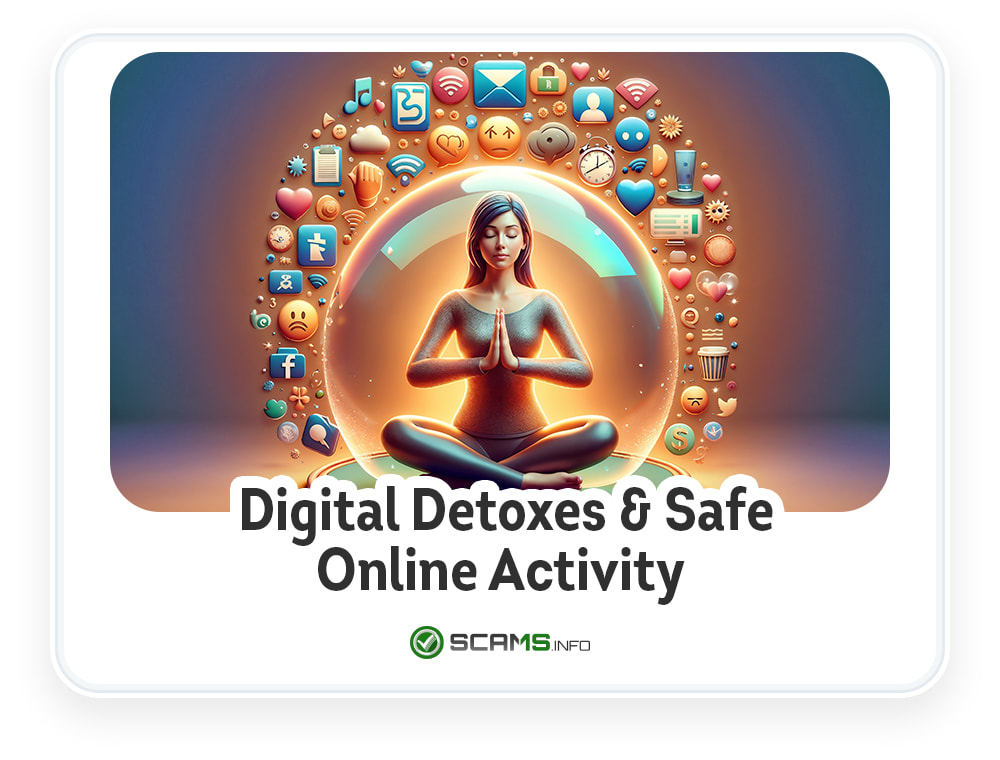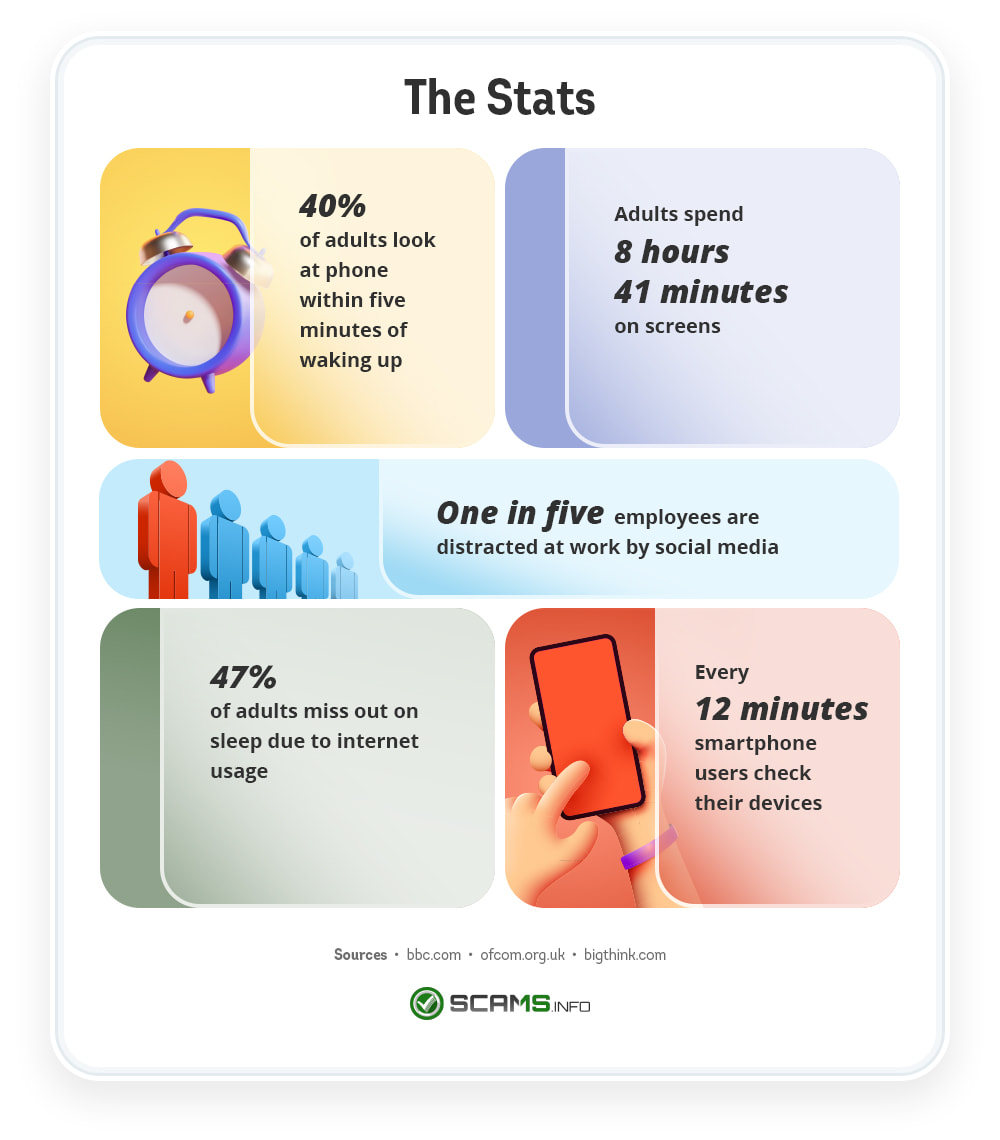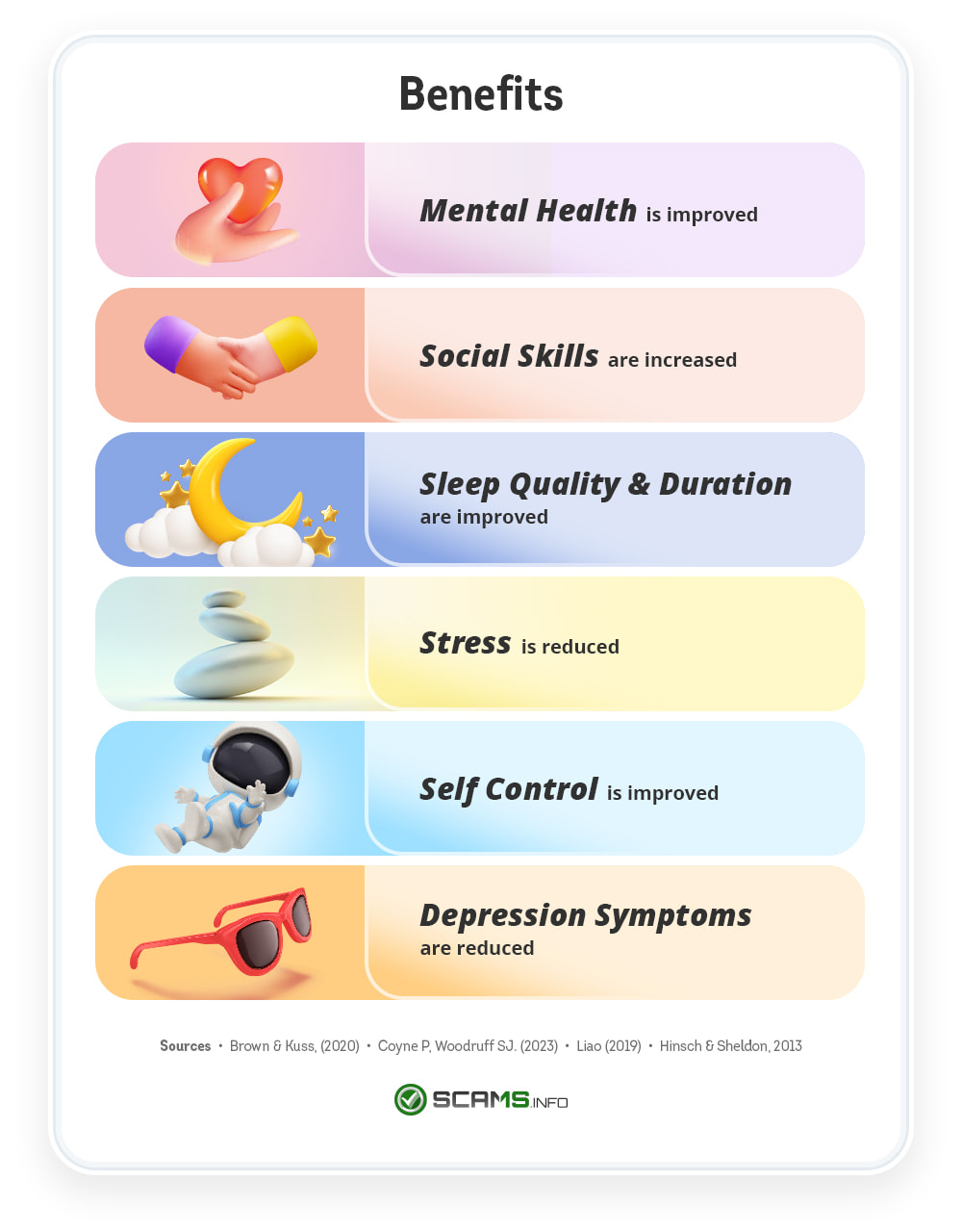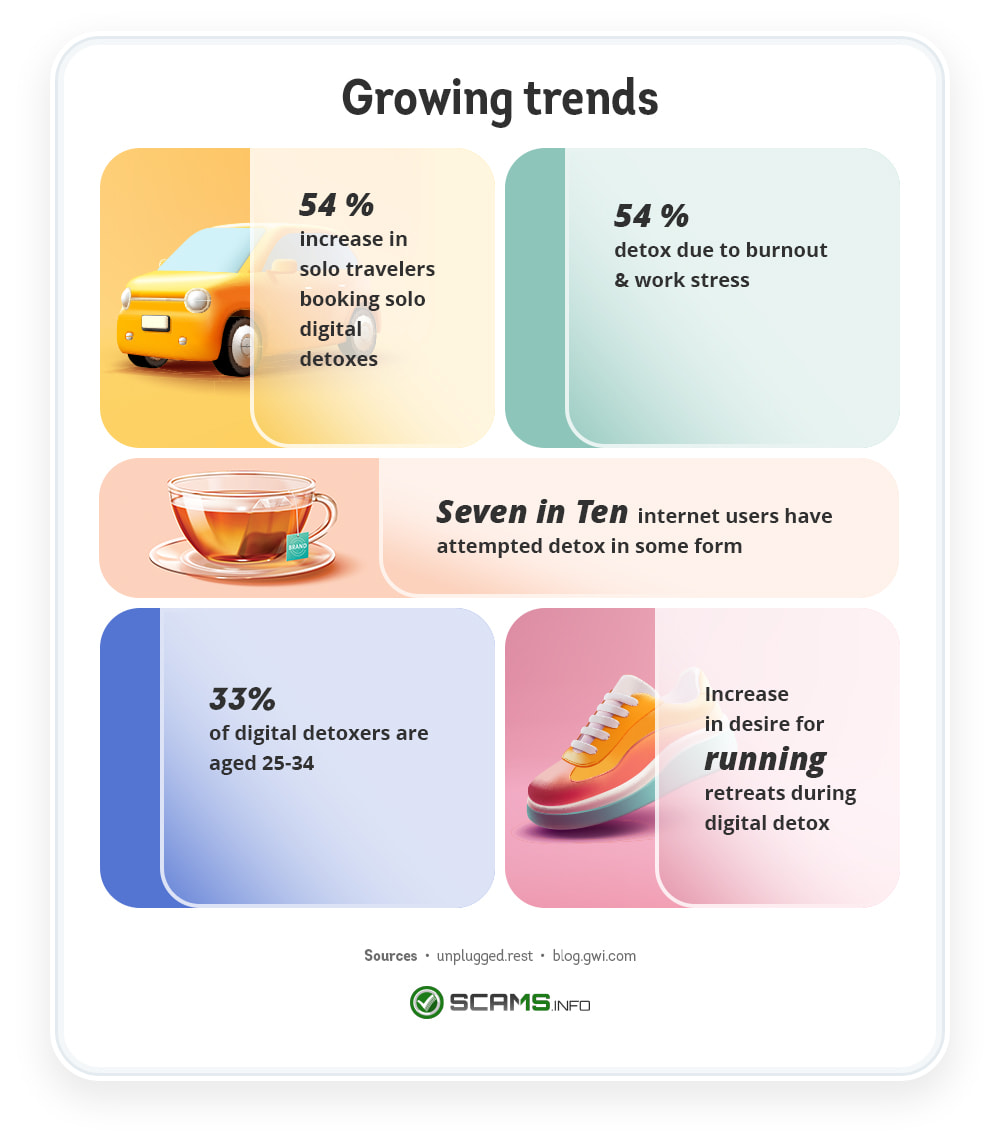Unplug for Your Health: Navigating a Digital Detox & Safe Online Activity
In today’s hyper-connected world, we find ourselves constantly bombarded by digital stimuli. It often feels overwhelming, from notifications buzzing on our phones to endless doom scrolling on social media. This overload has led many to implement a digital detox to combat the adverse effects of our reliance on the digital world.

What is a Digital Detox?
A digital detox involves intentionally unplugging from digital devices and platforms for a designated period, with the aim of recharging both mind and body. This practice has gained traction in recent years as a response to the increasing awareness of the adverse effects prolonged digital engagement can have on mental health.
Carrying out a detox from technology can also contribute to improved online safety. By reducing your digital footprint, you can lower exposure to cybersecurity risks, such as phishing attacks or identity theft. We’ll guide you through the research findings below, detailing all the benefits.
What the Data Shows
Our team has delved into the data and found some worrying trends. For instance, the average person in the UK now spends an entire day online every week![1] This spans various activities, including work, social media, entertainment, and shopping, indicating an entrenched reliance on digital platforms for both personal and professional needs.

There’s even a word for the fear of being without your phone: Nomophobia, and it affects 66% of UK smartphone owners.[2] Considering the hyperconnected world we live in, where the phone has evolved from a communication tool to also serve as a digital wallet, ticket holder, GPS etc., we are not surprised by these numbers.
Benefits of Doing a Digital Detox
The evidence clearly points to the positive outcomes of engaging in a digital detox. Below, we explore the key advantages of taking a digital hiatus, each underlining the positive shifts that occur when we momentarily disconnect from the virtual world to reconnect with the real one.

Improved Mental Health
Looking at the data from numerous studies, it is safe to say that undertaking a digital detox can be associated with reductions in symptoms of anxiety and depression. Limiting time spent on social media and digital devices can lead to significant improvements in overall mental well-being. [3]
This seems to be particularly clear when it comes to social media. Platforms are awash with carefully curated “highlight reels” of peoples’ lives, showcasing their achievements, travels, relationships, and milestones. This can lead to a cycle of comparison, where individuals measure their own lives against these idealised snapshots.
Better Sleep
These kind of detoxes also improve both sleep quality and length. [4] By disconnecting from digital devices before bedtime, individuals can alleviate the disruptive effects of blue light exposure, which is proven to interfere with the body’s natural sleep cycle.
Moreover, reducing screen time before bed can help lessen bedtime anxiety and promote relaxation, leading to more restful and rejuvenating sleep. Therefore, the next time you find yourself reaching for your phone to scroll through Instagram, consider picking up a book instead.
Decreased Levels of Procrastination
We all know the feeling of losing hours to endless scrolling. Maybe you have an important project to work on, but suddenly hours have passed and all you’ve done is scroll on Instagram, watch countless YouTube videos and reply to WhatsApp messages.
A detox from technology can help combat this procrastination and provide a renewed sense of focus and motivation. [5] It not only removes the distraction but also helps enhance your focus and ability to concentrate more deeply, making it easier to start and complete tasks.
Growing Trends
The data reveals interesting patterns in emerging trends, indicating that stepping away from gadgets is particularly popular amongst millennials. Notably, 33% of individuals who engage in digital detoxes fall within the 25-34 age group. [6]
Millennials occupy a unique position as the final generation to experience a world both with and without widespread internet use. This duality has made them especially conscious of the downsides of perpetual connectivity, including its potential adverse effects on mental health, social abilities, and life quality in general.

The need to detox from technology has also birthed a whole new sector within the travel industry. There are now companies offering digital detox retreats, which are specialised getaways designed to help people disconnect from digital devices.
These retreats typically take place in serene natural settings, away from the distractions of everyday life. Some may also incorporate educational workshops on digital wellness, stress management, and mindful living to equip participants with tools for maintaining a healthier relationship with technology.
Strategies to Try
A digital detox doesn’t adhere to a one-size-fits-all approach; instead, it encompasses a variety of strategies. These can range from establishing screen time limits and designating set periods without devices to participating in activities away from screens, like exercising.

Studies have shown that incorporating these habits into a routine can lead to long-term changes in digital behaviour. If you’re considering cutting back on your screentime, then here’s some different strategies you can try:
- App Cleanse: Going through your phone and deleting apps that you know you waste too much time on.
- Mini Detox: Taking short breaks at set times throughout the day from digital devices. This could be during work hours for example, or in the hours before bed.
- Digital Diet: Restricting digital intake to essential activities like checking emails and replying to messages.
- Turn Off Notifications: Many people find turning off or limiting notifications or emails can be super helpful and stops them getting distracted.
- Physical Distance: Putting some distance between yourself and your phone, for example placing it outside of the bedroom to reduce nighttime usage.
Tracking your screentime is a great first step. By monitoring how much time you spend on your devices, you can gain a clear insight into the extent of your consumption. It might seem scary at first, the numbers will probably be higher than you’re expecting, but the first step towards change is awareness.
The Importance of Building Safe Online Habits
Beyond simply unplugging, practicing safe online habits is also crucial in today’s digital landscape. This includes being mindful of the content we consume, staying vigilant against disinformation and steering clear of scams.
A digital detox is a great way to improve your online safety, because it encourages a more mindful and deliberate approach to technology use, prompting you to reassess your online behaviour and security practices.
By implementing online safety tips such as using strong passwords, being selective about the information we share, and understanding privacy settings, we help enhance our digital well-being. A great example of this can be seen in the payment methods we use online daily. If we pay attention to which methods we choose, we can help reduce the risks of sensitive financial information being stolen online. By opting for safer payment methods like bank transfers, we can reduce the risks associated with digital payments.
Regularly disconnecting serves a dual purpose: it refreshes our mental state and reduces our reliance on digital devices, while also emphasising the necessity of a secure and healthy digital presence.
Finding Balance in a Digital World
To sum up, a digital detox offers a valuable opportunity to step back from digital noise and prioritise mental well-being. By incorporating the above strategies and adopting safe online practices, we can navigate the digital world more mindfully and cultivate a healthier relationship with technology.
If a digital detox sounds impossible to you, then a ‘digital diet’ could be a good alternative. The key is being more mindful and cutting back, not necessarily cutting technology out completely.
Frequently Asked Questions
As you embark on your journey towards a healthier relationship with technology, you may have some lingering questions about getting started with a digital detox. Here, we provide answers to some of the most common queries to support you in your digital wellness journey.
What is a digital detox?
A digital detox is a period during which an individual intentionally disconnects from digital devices and online activities, such as smartphones, computers, and social media platforms, in order to reduce stress, increase mindfulness, and various other benefits.
How long should a digital detox last?
The duration of a digital detox can vary depending on individual preferences and goals. Some people may choose to detox for a weekend, while others may opt for a week or even longer. There are also various different strategies, with some people opting to simply cut back rather than completely detox.
Does a digital detox work?
Yes, a digital detox can be effective for reducing stress, improving focus and promoting overall well-being. Numerous studies have shown the positive impact of unplugging from digital devices. It can also help you reevaluate your relationship with the internet and keep you safe online.
How to digitally detox?
To digitally detox it is important to set clear goals, establish boundaries on screen time, practice mindfulness with technology use and engage in offline activities. Awareness is important. The same goes for general online safety.
References
- Hymas, C, 2018. A decade of smartphones: We now spend an entire day every week online. The Telegraph. [online] Available at: https://www.telegraph.co.uk/news/2018/08/01/decade-smartphones-now-spend-entire-day-every-week-online/ [Accessed 15 March 2024].
- https://www.telegraph.co.uk/technology/news/9084075/Rise-in-nomophobia-fear-of-being-without-a-phone.html
- Brown L, Kuss DJ., 2020. Fear of Missing Out, Mental Wellbeing, and Social Connectedness: A Seven-Day Social Media Abstinence Trial. Int J Environ Res Public Health. Available at: https://www.ncbi.nlm.nih.gov/pmc/articles/PMC7345987/ [Accessed 15 March 2024].
- Coyne P, Woodruff SJ. (2023). For Better or Worse: Understanding Smartphones and Social Media Use Among a New Generation of Young Adults and the Impact of Their Usage on Well-being. Media Watch Available at: https://journals.sagepub.com/doi/10.1177/09760911231213346?icid=int.sj-full-text.similar-articles.4 [Accessed 15 March 2024].
- Hinsch, Christian & Sheldon, Kennon. (2013). The impact of frequent social Internet consumption: Increased procrastination and lower life satisfaction. Journal of Consumer Behaviour. Available at: https://www.researchgate.net/publication/259535962_The_impact_of_frequent_social_Internet_consumption_Increased_procrastination_and_lower_life_satisfaction/citation/download [Accessed 15 March 2024].
- Winther Paisley, E, 2018. 1 in 5 Consumers are Taking a Digital Detox. GWI. [online] Available at: https://blog.gwi.com/chart-of-the-week/1-in-5-consumers-are-taking-a-digital-detox/ [Accessed 14 March 2024].
- Ridley, L., 2016. Social Media Makes 7 Million Brits ‘Depressed’ Looking At Friends’ Perfect Lives. HuffPost UK. Available at: https://www.huffingtonpost.co.uk/entry/social-media-depression-happiness_uk_57055d97e4b0e9cdf8df671a [Accessed 15 March 2024].
- Brown L, Kuss DJ., 2020. Fear of Missing Out, Mental Wellbeing, and Social Connectedness: A Seven-Day Social Media Abstinence Trial. Int J Environ Res Public Health. Available at: https://www.ncbi.nlm.nih.gov/pmc/articles/PMC7345987/ [Accessed 15 March 2024].
